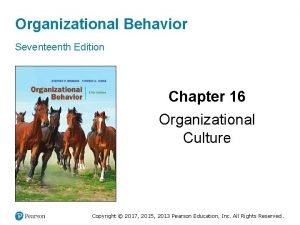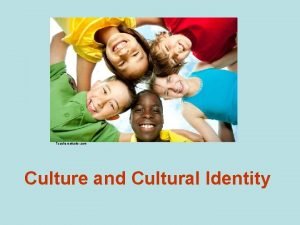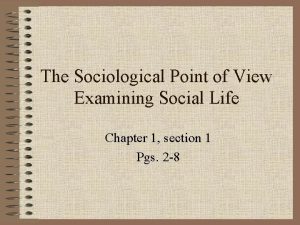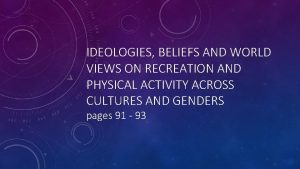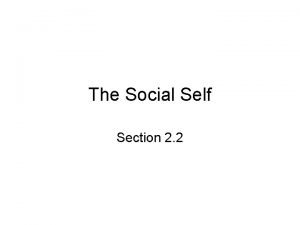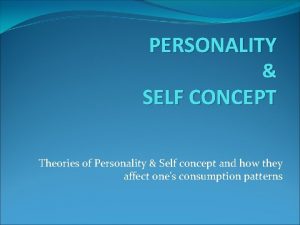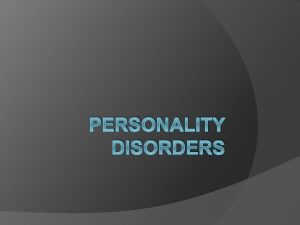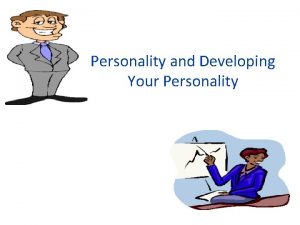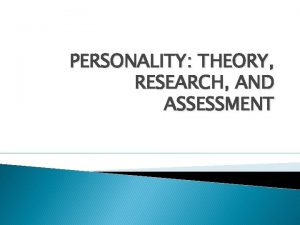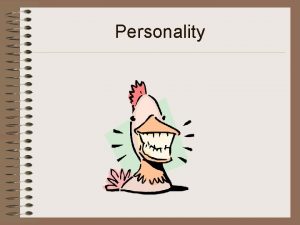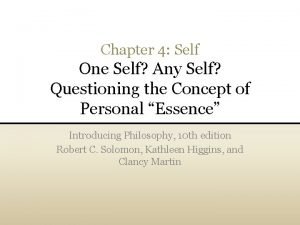Culture Self and Personality Cultures Impact on Personality




























- Slides: 28

Culture, Self, and Personality

Culture’s Impact on Personality § Before highlighting some important concepts and research findings noted by Matsumoto and Juang, I need to set the stage. § To start, the human personality and how it develops has stimulated the interest of scholars long before Sigmund Freud proposed his revolutionary ideas.

Role of Culture § When the role of cultures is brought in, theoretical controversy becomes more pronounced. § In fact, underscoring the need for a cross-cultural perspective in psychology, The Five Factor Theory, the most well-known attempt at pulling together research on personality, does not formally address to role of culture.

“The Big Five” § Neuroticism (N 3) - Depression: a tendency to experience dysphoric effect (sadness, helplessness & guilt). § Extraversion (E 2) - Gregariousness: a preference for companionship and social stimulation.

§ Openness to Experience (O 4) - Action: a need for variety, novelty & change. § Agreeableness (A 4) - Compliance: a willingness to defer to others during interpersonal conflict. § Conscientiousness (C 4) - Achievement striving: a strong sense of purpose and high aspiration levels.

Culture and Theoretical Perspectives § Broadly speaking, there are three contrasting views of personality development: § § § CONFLICT MODEL (Freud) FUULFILLMENT MODEL (Humanistic) CONSISTENCY MODEL (Cognitive)

Freud’s Intra-psychic Model § Even at the purely theoretical level, as you will see, the role which culture plays varies according to model. . § Conflict Model - Culture plays an inhibitory or repressing role. - As stated in the title of Jules Henry’s book, it’s “Culture against Man“.

The Humanistic/Existential Model § Fulfillment Model - Culture provides various channels for self realization. - According to Bronislaw Malinowski, “…every type of civilization, every custom, material object, idea, and belief fulfills some vital function, has some task to accomplish, represents an indispensable part within a working whole”.

- Hence, according to the Fulfillment Model, culture is not against man, but rather culture allows various human needs to be met and goals attained.

The Consistency or “Cognitive” Model § Consistency Model --The role of culture is to reduce anxiety. --Culturally based routines enable predictable patterns of behavior which in turn keep anxiety low. --Culture provides structure and meaning in our lives.

Culture and Concepts of Self § Our sense of Self is at the core of our being, and consciously and unconsciously, influences our every thought, action, and feeling. § The self “makes sense” within an individual’s culture. § Example: In Individualistic Cultures the self is seen as internal attributes, including needs, abilities, motives, and rights. § Different cultures produce different self-concepts.

Independent and Interdependent Selves § Independent Construal of Self § To maintain the independence of the individual as a separate, self-contained entity. § Individuals focus on personal, internal attributesindividual ability, intelligence, personality traits, goals or preferences-expressing them in public and confirming them in private.

§ Interdependent Construal of Self § To fit in and maintain the interdependence among individuals. § The self is unbounded, flexible, and contingent on context. The most salient self is defined in relationships.

Graphical Illustration (from text) Father Mother X XX Self: X X Sibling XX X Friend Mother X X Coworker Independent Construal of Self Father X X XX X Self: X X X Sibling X X X X Friend Coworker Interdependent Construal of Self Bold X’s=most salient self

Consequences § Self-Perception § Several studies have supported the notion that with an independent self, internal attributes are most salient and less salient for interdependent selves. § In research by Bond & Tak-Sing’s (1983), subjects wrote down as many of their own characteristics. § One response type was abstract. § Another response was situation specific.

Consequences (cont. ) § Findings confirmed that Americans with independent self concepts reported more abstract types, whereas Asians with interdependent self views reported more situation specific. § Interdependent Selves find it difficult to describe themselves in abstract internal attributes (“I am sociable”)

Consequences (cont. ) § Social Explanation § Self construals serve as a cognitive templates for interpreting behaviors of others as well. § Those with independent selves assume other people are the same. § Fundamental Attribution Error - the bias to explain another’s behavior in terms of your own construal of self.

Consequences (cont. ) § J. G. Miller (1984) examined patterns of social explanation in Americans and Hindu Indians. § Both were asked to describe someone they knew well who did something good for another person or who did something bad and explain why. § Americans described behavior in terms of general dispositions, whereas Hindus provided explanations in terms of the actor’s duties, social roles, and other situation-specific factors.

Consequences (cont. ) § Achievement Motivation or Need for Achievement refers to desire for excellence § Independent Construal - excellence linked to individual’s tendency to push himself or herself ahead and see individual success. Motivated by individual achievement. § Interdependent Construal - excellence sought to achieve broader social goals. Motivated by collective or group achievement/

Consequences (cont. ) § Yuang (1982) distinguished between individually oriented and socially oriented achievement motivation. § Yu (1974) related this to filial piety (duties and obligations to family members, especially parents). § Bond (1986) found that Chinese show higher levels of socially oriented motivation.

Consequences (cont. ) § Self-Enhancement - a collection of psychological processes by which individuals reinforce or enhance their self-esteem. § In the U. S. people tend to exhibit a self-serving bias (attribute good deeds and successes to our own internal attributes but bad deeds or failures to external factors (Bradley, 1978).

Consequences (cont. ) § In the U. S. people also use the false uniqueness effect (consider themselves to be more intelligent and more attractive than average). § These construals are not prevalent outside of the U. S. § Japanese students claimed that 50% of other students would be better than them and attributed success to good luck and failures to insufficient abilities.

Consequences (cont. ) § Social Connotation of emotion (positive and negative) § Socially disengaged emotions tend to separate or disengage the self from social relationships and to promote the perceived independence of the self from those relationships. § Socially engaged emotions further engage and assimilate the self in the relationship and enhance the perceived interdependence of the self with relevant others.

Consequences (cont. ) § Social Connotation and Indigenous Emotions (culture-specific emotions) § Anthropological Studies suggest that some socially engaged emotions are virtually absent in Western cultures.

Consequences (cont. ) § Lutz (1988) studied Micronesian cultures and found one emotion central to the culture. § Fago - a combination of compassion, love, and sadness (socially engaged emotion). § Ker - combination of happiness and excitement (perceived as dangerous and socially disruptive)

Consequences (cont. ) § Happiness - most generic, unqualified state of feeling good (relaxed, elated, and calm) § People experience this feeling when they have successfully accomplished the cultural task involving either independence or interdependence.

Consequences (cont. ) § Kitayama, Markus, Kurokawa, and Negishi (1993) asked Japanese and American undergraduates to report how often they experienced different emotions. § For American students, generic positive emotions were associated with socially disengaged emotions (pride), whereas for Japanese students, generic positive emotions were associated with socially engaged emotions (feelings of respect).

Consequences (cont. ) Another study by Oyserman (1995)-studied European Americans and African Americans concepts of self on school persistence § Findings supported multiple concepts of self. Cultural Reaffirmation-bicultural individuals identify more closely with their native culture. § Matsumoto et al(1997)-found that Japanese Americans are more collectivistic than Japanese nationals.
 Organizational cultures often reflect national culture.
Organizational cultures often reflect national culture. Differentiate ideal self from real self
Differentiate ideal self from real self Globalization of anime
Globalization of anime Example of material culture
Example of material culture Fed-batch
Fed-batch Indian vs american culture
Indian vs american culture Uses of selenite f broth
Uses of selenite f broth Folk culture and popular culture venn diagram
Folk culture and popular culture venn diagram Folk cultures are spread primarily by
Folk cultures are spread primarily by Anaerobic medium
Anaerobic medium Homework due today
Homework due today Carpet culture method
Carpet culture method Lawn or carpet culture
Lawn or carpet culture Surface culture deep culture and esol
Surface culture deep culture and esol Cultural identity
Cultural identity Examining social life
Examining social life Recreational activities across cultures and genders
Recreational activities across cultures and genders Chapter 20:1 operating the microscope
Chapter 20:1 operating the microscope Indulgence vs restraint hofstede
Indulgence vs restraint hofstede Atakapans
Atakapans What aspects of minoan culture did the mycenaeans adopt
What aspects of minoan culture did the mycenaeans adopt Cultures and organizations software of the mind
Cultures and organizations software of the mind Tandem language
Tandem language The stone ages and early cultures
The stone ages and early cultures Police personality and culture
Police personality and culture I self and me self difference
I self and me self difference Self confidence and self awareness eyfs
Self confidence and self awareness eyfs I-self and me-self
I-self and me-self Individual culture traits combine to form culture patterns.
Individual culture traits combine to form culture patterns.
